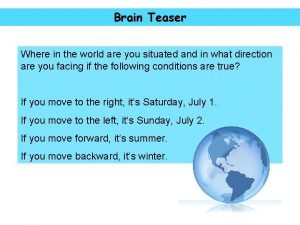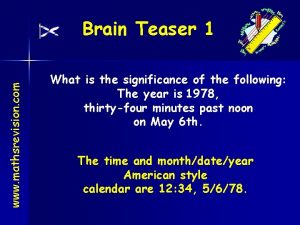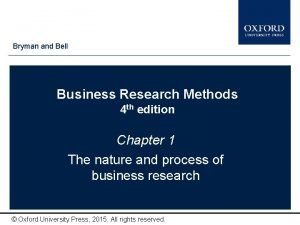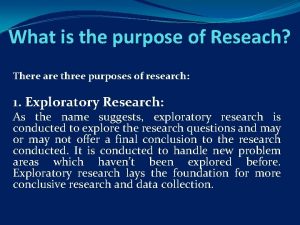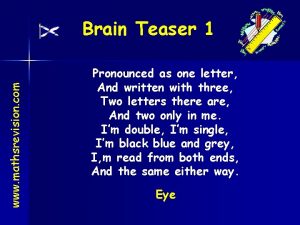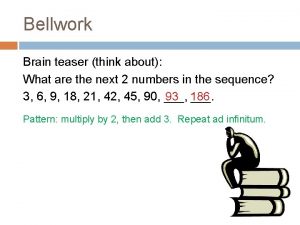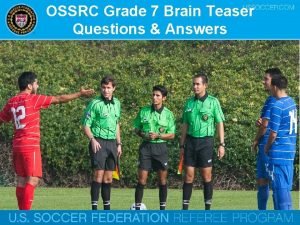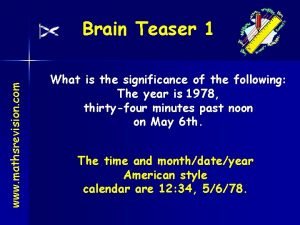IC Research Seminar A Teaser lionsepfl Prof Dr

































- Slides: 33

IC Research Seminar A Teaser lions@epfl Prof. Dr. Volkan Cevher LIONS/Laboratory for Information and Inference Systems

Major trends higher resolution / denser sampling x large numbers of sensors 160 MP Motivation: x increasing # of modalities / mobility solve bigger / more important problems decrease acquisition times / costs entertainment / new consumer products…

Problems of the current paradigm • Sampling at Nyquist rate – expensive / difficult • Data deluge – communications / storage • Sample then compress – inefficient / impossible / not future proof

Recommended for you: A more familiar example • Recommender systems – observe partial information “ratings” “clicks” “purchases” “compatibilities”

Recommended for you: A more familiar example • Recommender systems – observe partial information “ratings” “clicks” “purchases” “compatibilities” • The Netflix problem – from approx. 100, 000 ratings predict 3, 000 ratings – 17770 movies x 480189 users – how would you automatically predict?

Recommended for you: A more familiar example • Recommender systems – observe partial information “ratings” “clicks” “purchases” “compatibilities” • The Netflix problem – from approx. 100, 000 ratings predict 3, 000 ratings – 17770 movies x 480189 users – how would you automatically predict? – what is it worth?

Theoretical set-up • Matrix completion for Netflix users movies

Theoretical set-up • Matrix completion for Netflix users movies • Mathematical underpinnings: compressive sensing (adversarial) perturbations observations linear (sampling) operator CS: when we have less samples than the ambient dimension

Linear Inverse Problems myriad applications involve linear dimensionality reduction from geophysics to medical imaging (MRI) from quantum tomography to cancer prediction Many names: compressive sensing, regression, sketching, …

Linear Inverse Problems • Challenge:

Linear Inverse Problems Prior Metric Deterministic Probabilistic sparsity low-rank prior likelihood posterior

Back to theoretical set-up • Matrix completion for Netflix 17770 movies x 480189 users movies • What is low-rank?

Back to theoretical set-up • Matrix completion for Netflix 17770 movies x 480189 users movies • What does the simple low-rank assumption buy? quite a lot of extrapolation power!


people@lions three Current line-up: Volkan Cevher Bubacarr Bah Luca Baldassarre Quoc Tran Dinh Tasos Kyrillidis Marwa El Halabi Starting January: Manzil Zaheer Trainees: Nima Pourdamghani Ali Sadeghian and do this fast with theoretical guarantees

teaching@lions • Theory and methods for linear inverse problems – Wednesday / Friday 10 -12 + recitations • Graphical models (last two years) – 2010: Graphical models – 2011: Probabilistic graphical models (w/ Matthias Seeger) • Circuits and systems (undergrad)

research@lions Themes: • Theoretical foundations of low-dimensional models – tractability, sample complexity, phase transitions, … • Convex geometry in high-dimensions – polytopes, tangent cones, theta body relaxations, … • Randomness in high-dimensions – concentration-of-measures, expansions, sparsifiers… • Convex and combinatorial optimization – convergence rates, submodular optimization, … • Analysis and design of algorithms – accelerated methods, game theoretic methods, … see: http: //lions. epfl. ch

projects@lions

Sampling/sketching design scene +Coding theory +Theoretical computer science +Learning theory +Databases single photon detector DMD random pattern on DMD array • Structured random matrices • 1 -bit CS • expanders & extractors DMD image reconstruction or processing

Structured recovery • Sparsity +Theoretical computer science +Learning theory +Optimization +Databases sorted index Sparse vector only K out of N coordinates nonzero

Structured recovery • Sparsity +Theoretical computer science +Learning theory +Optimization +Databases sorted index Structured sparse vector only certain K out of N coordinates nonzero

+Theoretical computer science +Learning theory +Optimization +Databases Structured recovery • Structured sparsity + requires smaller sketches + enhanced recovery + faster recovery support of the solution <> modular approximation problem integer linear program matroid structured sparse models clustered /diversified sparsity models tightly connected with max-cover, binpacking, knapsack problems • Recovery with low-dimensional models, including low-rank…

Quantum tomography • Quantum state estimation +Theoretical computer science +Databases +Information theory +Optimization a state of n possibly-entangled qubits takes ~2 n bits to specify, even approximately • Recovery with rank and trace constraints with M=O(N) 1. Create Pauli measurements (semi-random) 2. Estimate Tr( i ) for each 1≤i≤M 3. Find any “hypothesis state” st Tr( i ) for all 1≤i≤M • Huge dimensional problem! ─ (desperately) need scalable algorithms ─ also need theory for perfect density estimation

Learning theory and methods+Learning theory +Optimization +Information theory +Theoretical computer science • A fundamental problem: given • Our interest learn a mapping <> non-parametric functions graphs (e. g. , social networks) dictionary learning… • Rigorous foundations <> sample complexity approximation guarantees tractability • Key tools <> sparsity/low-rankness submodularity smoothness

Compressible priors • Goal: +Learning theory +Information theory seek distributions whose iid realizations can be well-approximated as sparse Definition: relative k-term approximation: sorted index

Compressible priors • Goal: +Learning theory +Information theory seek distributions whose iid realizations can be well-approximated as sparse Classical: New: sorted index

Compressible priors • Goal: +Learning theory +Information theory seek distributions whose iid realizations can be well-approximated as sparse • Motivations: deterministic embedding scaffold for the probabilistic view analytical proxies for sparse signals – learning (e. g. , dim. reduced data) – algorithms (e. g. , structured sparse) information theoretic (e. g. , coding) lots of applications in vision, image understanding / analysis

Final remarks: there a lot more problems… looking for joint advising… • Reconstruction with low-dimensional methods + databases? motivation: a principled way of coping with the data deluge system techniques <> EX: 8 bits QT single computer | limited by algorithm 32 bits QT limited by flops + storage + time online aggregation >> dynamic graph streams >> computational + storage + time bottlenecks real-time responsiveness with probabilistic/deterministic approximation guarantees sketching for storage bottlenecks with probabilistic/deterministic approximation guarantees

Final remarks: there a lot more problems… • Lots of interesting theoretical + practical problems @ LIONS – game theoretic sparse/low-rank recovery – approximate message passing – non-negative matrix factorization – portfolio design – density learning – randomized linear algebra – sublinear algorithms – …

volkan. cevher@epfl. ch

• A linear inverse problem

• Naïve reconstruction

• reconstruction with low-dimensional methods
 Contoh copywriting teaser
Contoh copywriting teaser Teaser lead
Teaser lead Riddles fruit
Riddles fruit Connect the waves brain teaser
Connect the waves brain teaser Plasma h2o brain teaser
Plasma h2o brain teaser S-5280 ft brain teaser
S-5280 ft brain teaser Try to decode these words and phrases
Try to decode these words and phrases Teaser message
Teaser message I dig out tiny caves
I dig out tiny caves Flush line headline
Flush line headline Teaser
Teaser Teaser
Teaser Reliability in research example
Reliability in research example Operational definition of variables psychology
Operational definition of variables psychology Prof ram meghe institute of technology and research
Prof ram meghe institute of technology and research Research report vs research proposal
Research report vs research proposal Site:slidetodoc.com
Site:slidetodoc.com Appendix sample
Appendix sample Design research meaning
Design research meaning Research scope definition
Research scope definition Qualitative research
Qualitative research Contrast applied research and basic research
Contrast applied research and basic research Technique involved in defining a problem
Technique involved in defining a problem Research paradigm example
Research paradigm example Operational thought
Operational thought Causal-comparative/quasi-experimental research
Causal-comparative/quasi-experimental research Chapter 3 research parts
Chapter 3 research parts Examples of applied research
Examples of applied research Bryman bell
Bryman bell Reseach
Reseach Quantitative qualitative
Quantitative qualitative Inquiry in practical research 2
Inquiry in practical research 2 Exploratory research vs conclusive research
Exploratory research vs conclusive research Types of research design exploratory descriptive causal
Types of research design exploratory descriptive causal



